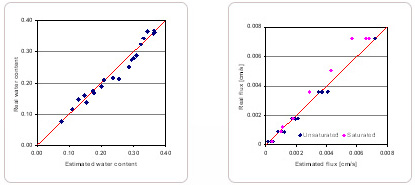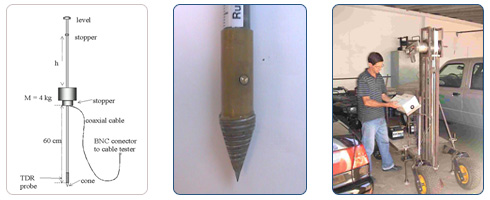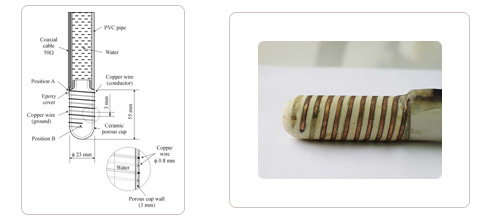 |
Download: Presentation |
Usually, soil physical characterization requires more than a single soil measurement type. For example, variables such as soil water content, matric potential and solute concentration are typically needed simultaneously. Consequently, the presence of soil heterogeneity mandates that these different measurements are taken at the same location, and that each measurement type integrates over approximately identical measurement volumes, thereby minimizing soil heterogeneity effects. In general, though, when more than a single soil variables or parameter is measured, multiple instruments are used, with their measured values pertaining to different soil locations and measurement volumes.
The overall motivation for the development of these multi-functional techniques
is to achieve an improved characterization of flow and transport processes.
Several benefits are achieved by combining measurements. First, by measuring
several parameters at the same time and place, the coupling of related
transport properties are determined in concert, thereby allowing examination
of the nature of their interdependency, such as for the coupled transport
of water and solute, and water and heat. Second, by using the same instrument
for various measurements within approximately the same measurement volume
at about the same time, the need to interpolate different measurement
types in space and time is largely eliminated. Thirdly, simultaneous analysis
of flow and transport using combined soil measurements of water content,
temperature, and solute concentration, decreases parameter uncertainty.
Thus, using multi-functional measurement techniques allows determination
of inter-dependent soil properties and processes, providing an improved
understanding of coupled flow and transport.
A. Multi-functional heat pulse probe
B. Combined tensiometer-soil solution sampler
C. TDR-penetrometer and TDR-tensiometer
____________________________________________________________
A. Multi-functional heat pulse probe

The proposed multi-functional heat pulse probe (MFHHP) originates from the dual-probe heat-pulse (DPHP) method, who demonstrated that the DPHP method provides for an alternative means to measure soil water content, in addition to the measurement of the soil’s thermal properties. It has also been shown that a DPHP with two additional sensors for bulk soil electrical conductivity measurements allows for the simultaneous measurement of soil solution concentration. In recent years, others have demonstrated that the temperature responses of the upstream and downstream sensors of a 3-sensor heat pulse probe (HPP) can be used to indirectly estimate the water flux density. We proposed an inverse modeling procedure by which thermal properties, water content and water fluxes can be determined using a multi-sensor HPP, by including both conductive and convective heat transport in the two-dimensional heat flow equation and by accounting for dispersive heat transport as caused by pore water flow variations. Whereas various studies have demonstrated that heat pulse probe analysis can be applied to the measurement of multiple soil properties, the proposed MFHHP was developed for the simultaneous analysis and measurement of water flow, solute and thermal transport properties.

In a subsequent study, a small multi-functional sensor with 6 sensors that includes a heater, four thermistors and four Wenner-array electrodes was developed. We have evaluated the accuracy of the MFHPP, regarding its application to determine the water content dependency of the soil’s volumetric heat capacity and heat diffusivity, using the transient temperature responses of each of the 4 thermistors during multi-step outflow experiments. In addition, the potential application of using the MFHHP to measure bulk soil electrical conductivity and water fluxes, simultaneously with the soil water content and thermal property measurements has been shown.
In 2004 we received NSF funding to further develop the MFHPP for field applications.
References:
Hopmans, Jan W., K.L. Bristow, and J. Simunek. 2001. Indirect estimation of soil thermal properties and water flux from heat pulse measurements: Geometry and dispersion effects. Water Resources Research 38(1):7-1 to 7-14: DOWNLOAD: PDF
Mori, Y., J.W. Hopmans, A.P. Mortensen, and G.J. Kluitenberg. 2003. Multi-functional heat pulse probe for the simultaneous measurement of soil water content, solute concentration and heat transport parameters. Vadose Zone Journal DOWNLOAD: PDF
Mori, Y., J.W. Hopmans, A.Mortensen and G.J. Kluitenberg. 2005. Estimation of vadose zone water flux from multi-functional heat pulse probe measurements. Soil Sci. Soc. Amer. J; DOWNLOAD: PDF
Mortensen, A., J.W. Hopmans, Y. Mori and J. Simunek. 2005. Inverse modeling
of water, heat, and solute transport in the vadose zone applying a multi-functional
heat pulse technique. Advances in Water Resources. DOWNLOAD:
PDF
B. Combined tensiometer-soil solution sampler

The proposed combined sampling probe minimizes soil disturbance by integrating the two sensors into a single unit. Construction of the combined probe requires two separate porous ceramic compartments. The presented design includes a PVC dowel machined to fit into the upper porous ceramic compartment, allowing for a separation between the two compartments, thereby eliminating possible interactions between the tensiometer and solution extraction measurements. The ceramic cup assembly is cemented to the bottom of the PVC pipe, so that soil water matric potential can be measured by inserting a needle of a pressure transducer into the rubber septum. Two holes are drilled in the top of the PVC and the acrylic barrier to guide the sampling tubes to the bottom compartment of the probe. One sampling tube feeds just through the barrier while the other tubing extends to the bottom of the porous ceramic cup. The long tube is used for vacuum application to the extracted soil solution, and removes the solution from the sample to the sample bottle above the ground. Alternatively, the vent tube can also be used to apply positive pressure to the solution compartment, thereby causing solution to flow into the sampling bottle. Laboratory experiments indicated that data obtained with the combined tension-solution sampling probe were close to measurements with conventional tensiometer and soil solution samplers.
Interaction between the solution sampler and tensiometer of the combined
probe can occur in two ways. First, the vacuum applied to extract soil
solution may reduce the soil water matric potential as measured by the
tensiometer compartment. This type of interaction is minimized by measurement
of the soil water potential before soil solution is extracted. Second,
soil solution concentration may be affected by the solute diffusion or
water exchange between the tensiometer compartment and the surrounding
soil. Both interactions can be minimized by increasing the distance between
the two compartments.
References:
Essert, S. and J.W. Hopmans. 1998. Combined tensiometer-solution sampling probe. Soiland Tillage Research 45(3-4):299-309 : DOWNLOAD: PDF

Soil cone penetrometers are used to characterize soil strength for assessment of soil trafficabillity, crop growing ability, resistance to root penetration, seedling emergence and soil compaction. Many studies have been conducted to understand the influence of soil dry bulk density and water content on penetration resistance (PR) in the laboratory, from which both empirical and theoretical relationships were obtained. However, these studies lack accurate and representative data, because PR is a highly variable soil property, whereas it is usually determined from local small-scale measurements. Hence, difficulties in relating PR with other soil parameters can be attributed mostly to soil heterogeneity, since available measurement techniques prevent determination of different soil properties such as density and water content, at the same spatial location. The so-called coiled cone penetrometer-TDR probe was developed to allow for simultaneous PR and water content measurements at the same spatial location. The presented probe design uses two parallel steel wires (conductor and ground) wrapped around the insulation-covered cone of a standard hammer penetrometer, thereby ensuring contact between the TDR coil and the surrounding bulk soil.
References
Vaz, C.M., L. Bassoi, and J. W. Hopmans. 2001. Influence of soil water content and bulk density on soil strength as determined from combined cone penetrometer-TDR probe field measurements. Soil & Tillage Research 1587:1-8: DOWNLOAD: PDF
Vaz, C.M., and J.W. Hopmans. 2001. Simultaneous measurements of soil penetration resistance and water content with a combined penetrometer-TDR moisture probe. Soil Sci. Soc. Amer. J.65:4-12: DOWNLOAD: PDF
C2. TDR-tensiometer

Using the concept developed for the combined penetrometer-TDR probe, a combined tensiometer-TDR probe was developed that allows simultaneous water content and soil water matric potential measurements in both laboratory and field conditions. This instrument combines a regular tensiometer with a coiled TDR, wrapped around the porous cup of the tensiometer. Bulk soil water content can be determined from the dielectric constant measurements, whereas soil water matric potential is measured with a standard tensiometer. The main advantage of the presented combined probe design is the simultaneous measurement of soil water content and soil water matric potential for the same bulk soil volume around the porous cup. We calibrated the combined tensiometer-coiled TDR probe in the laboratory and applied the mixing model concept to explain the functional form of the coiled dielectric data. The pair of parallel wires (ground and conductor) were coiled using a 3-mm spacing along a standard 5-cm long porous cup (Soil Moisture Equipment, Santa Barbara, CA) of the tensiometer and were glued in the cup wall with epoxy.
Refererence:
Vaz, C.M. P., A. Macedo, L.H. Bassoi, D. Wildenschild and Jan. W. Hopmans. 2002. Retention curves obtained by a combined tensiometer-coiled TDR probe. Soil Science Society Journal 66:1752-1759. DOWNLOAD: PDF